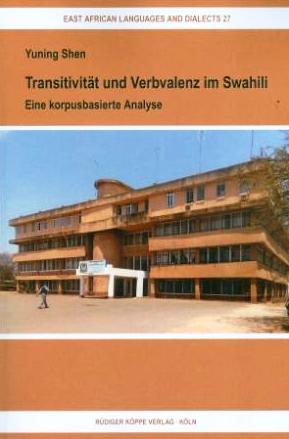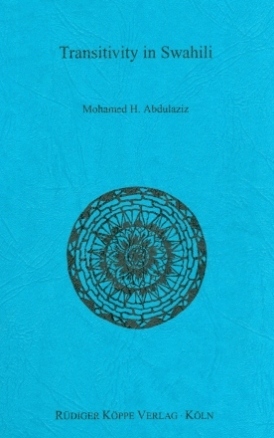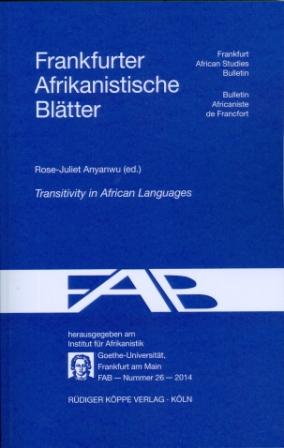




Transitivity in Swahili (or Kiswahili) grammar does not fit the paradigm of standard transitivity’s definition. Neither does verb valency. Transitivity in Swahili, as presented in dictionaries and pedagogical grammars (also in foreign language teaching), is conceived as the categorization of verbs, indicating the ability of a given verb, whether it demands a direct object or not. In order to testify the objecthood of a NP and therefore the transitivity of a verb, the method often involved is to scrutinize certain potential syntactical transformation of a verb, especially the ability of passivization, by deploying some fixed lexical items. However, the status of a transitive verb cannot easily be credited, because
(a) solely passivization forms provide no solid condition for judgement (Mkude 2005), and
(b) there are insufficient descriptions about the meaning and function of many morphemes in Swahili automatically triggered by certain syntactical transformation such as passivization,
(c) not engaging enough with the characteristics of intransitive verbs further shadowed the understanding of transitivity in Swahili, and ultimately,
(d) the highly idealized short examples from many grammar books hinder the detailed analysis of paired sentences both in rendering their meanings and in testifying their acceptance.
This study focuses distinctively on the language data provided by Helsinki Corpus of Swahili 2.0 and raises the question whether previous classifications of verbs properly mapped the language performance of Swahili speakers. Two tests are designed to profile the following features generally suggested as qualifying objecthood of certain NPs:
1) the likelihood of attracting a noun in the syntactic position following the verb form (referred to as noun affinity in this study);
2) the distribution of verb forms between those which occupied an object prefix and those which did not (referred to as the ability of object prefixation in this study).
The results conflicted with previous classifications in many ways and some of these are discussed intensively in this work.
In group C, through a method testing the possibility of permutation of same lexical items as Whiteley (1968) classified with his entailment model, the verb -vimba“(to) swell” exhibits extraordinarily higher noun affinity comparing to other members in this group. A qualitative analysis from this study suggests a rather widespread feature of intransitive verb: the allowance of the nominal coded ascription in the postverbal position which cannot be marked through object prefix in finite verb form. This nominal coded ascription or argument is conceptually very close to the subject noun through a PART-WHOLE relationship. The wide spectrum of this PART-WHOLE relationship made the author of the study call it “situational internalization (SitIn)”. Moreover, evidence shows that the object prefix certainly could be used with this intransitive verb. The condition has to be met that the object prefix can only be used for marking the argument which represent the concept of WHOLE, and additionally, the argument involved should always be signalled, contradicting the entailment represented by Whiteley (1968), in previous text.
Group B2 is a group of verbs which Whiteley (1968) noticed to exhibit not only the ability of passivization but also the ability of taking separative extension, revealing the overall highest noun affinity in postverbal positions. Two verbs from this group -funga “(to) tie, (to) close” and -pamba “(to) decorate; (to) cover, (to) spread” were also classified by Abdulaziz (1996) as to have three inherent participants. A qualitative analysis about -pamba in this study argues for the existence of a trivalent rendering of -pamba.
In these cases, the object prefix marked argument is assigned most likely the semantic roles of RECIPIENT or LOCATION; together with another nominal argument representing ACCESSOIRE, they form a different yet similar configuration of PART-WHOLE relationship on the edge of the canonically perceived PATIENT. However, a possible polysemic reading of -pamba in a less transitive environment codes exactly the same semantic roles RECIPIENT or LOCATION as subject (representing the concept WHOLE), such as in the idiom -pamba moto “be red-hot, be a hit; intensify”.
In conclusion, a preliminary study of transitivity and verb valency in Swahili by introducing corpus-based method has been made. Though the two categories in many cases interact, especially through the SitIn-feature, but however, a distinction of verbs based on their primary involvements in intransitive and transitive settings is still found to be possible and valid.
Review by Catherine Agoya-Wotsuna in Swahili Forum 27/2020
Review by Assibi A. Amidu, 20 Oct 2021 (see link below)
Under these links you will find further analyses of transitivity in Swahili and in other African languages:
Als Linguistin, die nicht im Swahili arbeitet, habe ich sehr viel über Transitivität im Swahili gelernt. Shen hat eine sehr interessante und gute Arbeit geleistet, und ich wünsche mir sehr, dass die Arbeit ins Englische übersetzt wird, damit Swahili-Linguist*innen im ostafrikanischen Raum sie rezipieren und manche Fragen [...] aufklären können. Außerdem wäre es wichtig, bei zukünftigen Studien Arbeiten zum Thema Transitivität, die bereits im ostafrikanischen Raum geschrieben worden sind, zu recherchieren und zu berücksichtigen.
Catherine Agoya-Wotsuna in Swahili Forum, 27/2020, i-iv
© 2025 by Rüdiger Köppe Verlag – www.koeppe.de